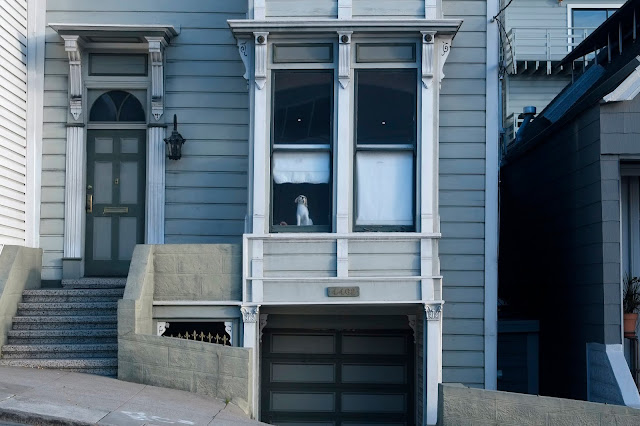 Sunrise comes later in October. This photo, taken at 7:28 (just 12 minutes after sunrise) reflects the warmth inherent in the early morning light, diffused from the morning clouds, and from a direction closely aligned with the lens axis. I gives a different take on the normal "safety yellow" reflecting strips nailed to this telephone pole. I suspect they were installed by the adjacent homeowner who probably uses them to help him back his car into his garage.
Sunrise comes later in October. This photo, taken at 7:28 (just 12 minutes after sunrise) reflects the warmth inherent in the early morning light, diffused from the morning clouds, and from a direction closely aligned with the lens axis. I gives a different take on the normal "safety yellow" reflecting strips nailed to this telephone pole. I suspect they were installed by the adjacent homeowner who probably uses them to help him back his car into his garage.
I was using the 50mm F 2.0 Fuji WR lens on my usual X-E1 body. As is always the case, the lens you need isn't always the lens on your camera, and since I have not abandoned my manual focus pilgrimage, I won't carry a zoom lens. This street shot allowed me to get as close to the reflectors as I wished, so any lens would have done. But even a short telephoto lens will "enlarge" the background, for lack of a better description, and gives the foreground a much better chance of capturing the viewer's attention. The out of focus background has a very creamy appearance, which adds to the implied softness of the light just after dawn.
I managed to make another photograph my favorite dog "house", but since I was carrying a telephoto lens, I needed to cross the street to get the shot. Normally, I'm standing right in front of the window, doing everything I could to minimize the keyhole effect of shooting at an up angle.
If you look closely, you can see the curved region which is a reflection of the roofline of the house behind me. By shooting from across the street, I actually reduced the amount of glare on the lower portion of the window, and thus protecting our favorite beagle from those blue sky reflections that decreased the contrast in my earlier photos.










